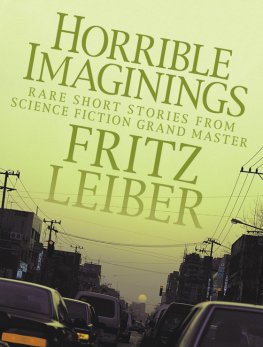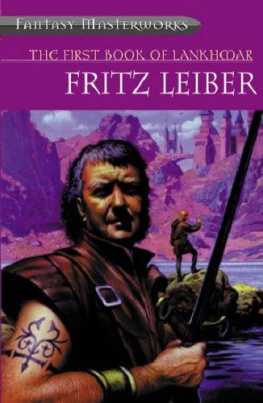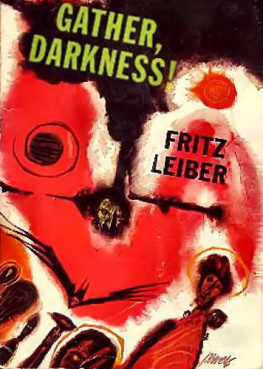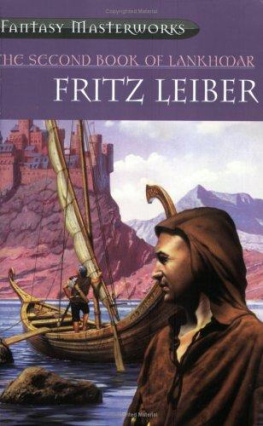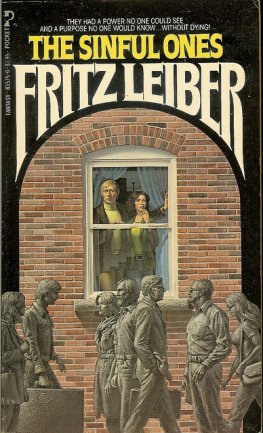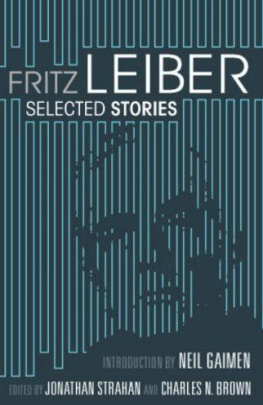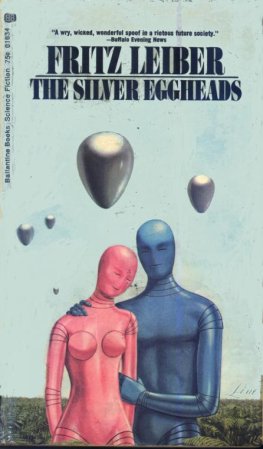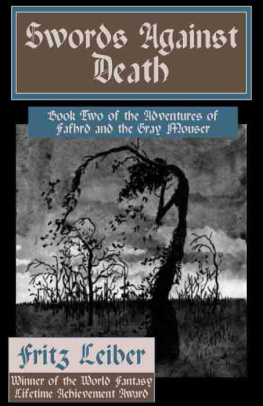Fritz Leiber
HORRIBLE IMAGININGS
The editor would like to acknowledge the invaluable assistance of Catherine Brown, Richard Curtis, Stefan Dziemianowicz, Allen Koszowski, Brian Metz of Green Rhino Graphics, Kathy Pelan, & David Read in the preparation of this volume.
Obviously, the author of these tales needs little introduction. Fritz Leiber was a master of imaginative fiction and a profound influence on the genres of horror, science fiction, and heroic fantasy. As comfortable putting his own unique spin on H.P. Lovecrafts as he was creating his own worlds, Leibers stories display a rare mastery in all the fields he touched.
This collection is another volume of his darker tales, selected from different points in a forty-year career. From his 1940 tale The Automatic Pistol to The Ghost Light from 1984, this collection presents a retrospective sampling of Leibers horror fiction. No doubt there are some familiar pieces here; certainly several of these stories have been frequently anthologized and will be familiar to Leiber fans. However, we are pleased to offer up a selection of stories that had vanished into relative obscurity. His short fantasies When Brahma Wakes and When Set Fled are minor masterpieces of the short-short form. One tale was discovered among the Leiber papers and to my knowledge has never seen prior publication. Skinnys Wonderful was found with a note from Leibers agent implying that he expected a sale to Esquire to be forthcoming To the best of my knowledge, this sale never took place and the story languished in an envelope, unsubmitted elsewhere.
Esquires loss is our gain; Skinnys Wonderful is an excellent Hitchcockian piece that shows Leibers excellence at the straight psychological suspense tale to great effect. Another rare inclusion is the short and poignant sword and sorcery tale When Set Fled from a 1961 issue of the Robert E. Howard journal Amra. Scream Wolf is another suspense tale, this time from the often-excellent Mike Shaynes Mystery Magazine. MSMM has undeservedly fallen into obscurity under the larger shadow of Alfred Hitchcock Mystery Magazine, but a perusal of 1960s and 1970s issues yields some nice surprises. In any given issue you may find stories by Weird Tales alumni such as Robert Bloch, Carl Jacobi, Theodore Sturgeon, and even Robert Barbour Johnson; to say nothing of early appearances by modern masters like Richard Laymon and Gary Brandner.
These are essentially the oddball items in this collection; assuming that you bought the first two Midnight House volumes of Leiber, youre here for the horror I must apologize and explain the somewhat eclectic nature of this series. When we began, we foolishly assumed that one or two volumes collecting rarer pieces would be adequate and that two volumes each of SF and horror would pretty well cover things. Such has been the popularity of the series that weve decided to forge ahead and collect all of Leibers non-Gray Mouser tales. There will be one such story published, but its the early, never-before-published version of Adepts Gambit, written as a Cthulhu Mythos tale! Sadly, I did not discover until well into the third book that Fritz had assembled a horror collection entitled Thirteen Dark Dreads. We will offer this title in 2005, but due to several of the stories appearing elsewhere, the contents will be radically different from what Fritz had envisioned. To that I can only offer up an apology for my eagerness to get The Black Gondolier and Smoke Ghost into print, and hope that you, the reader find that the dark dreads Ive selected meet with your approval.
The other tales from this volume may be familiar to a large extent; The Automatic Pistol was so overshadowed by Smoke Ghost that many have forgotten what an excellent early story this was. Other inclusions from the Weird Tales years are The Hound and Alice and the Allergy. Ive tended to leave aside the entire decade of the 1950s in favor of presenting early and still vital work which may be contrasted with three of Leibers latter-day masterpieces. In the 1970s and 1980s Stuart Schiffs phenomenal little magazine Whispers was an infrequently published delight, everything that Weird Tales should have been. Artists included the great Lee Brown Coye and Frank Utpatel and authors read like a whos who of the time period. Leiber, King, Campbell, Strieber, Wellman, Aickman, and newer authors like Karl Edward Wagner. David Campton, David Drake, and many others. Leibers story The Glove remains one of the most fondly remembered tales from that great magazine.
Editor Schiff was able to parlay his success from Whispers into a series of anthologies, while the Whispers series drew mainly from the magazine, his anthology Death was a non-themed horror anthology, he rounded up some top-flight authors that he knew could deliver the goods and left them to write whatever pleased them at whatever length. Fritz Leiber responded with the remarkable titular novella of this collection. A story which was also selected as best of the year for 1982 in The Centurys Best Horror.
Theres little I can say about The Girl with the Hungry Eyes, that hasnt already been remarked on by scores of critics. The quintessential 1950s horror story, its been reprinted a number of times and is readily available in many anthologies, but I thought it would be a shame to leave it out here.
Mysterious Doings at the Metropolitan Museum is more likely to raise a smile than a shiver (at least on initial reading), its only after the book has been set aside and we start to wonder about the secret nature of things that the chill starts to set in and the horripilations begin.
We end the book with a bit of a contrast, a story from early in Leibers career that I feel transcends its pulp tropes very effectively and we conclude with his last real masterpiece, The Ghost Light. The Ghost Light is an ambitious work that examines themes and motifs that have been present in Leibers work for years the dark magic of cities, alcoholism, loss, alienation, and of course our ability (or is it a need?) to create new ghosts for a modern era.
For over forty years no one did a more effective job of showing us our new ghosts than did Fritz Leiber, here are few of them for your enjoyment Do leave the light on and consider that the gray shape slowly detaching itself from the alley is probably just a shadow. Probably
John PelanMidnight HouseSummer Solstice 2004
Present fears are less than horrible imaginings.
Macbeth
Old Ramsey Ryker only commenced thinking about going to see (through one-way glass) the young women fingering their genitals after he started having the low-ceilinged dreams without lightthe muttering dull black nightmaresbut before he began catching glimpses of the vanishing young-old mystery girl, who wore black that twinkled, lurking in the first-floor ground-level corridors, or disappearing into the elevator, and once or twice slipping along the upstairs halls of the apartment tree (or skeleton) that is, with one exception, the sole scene of the action in this story, which does not venture farther, disturb the privacy of the apartments themselves, or take one step out into the noisy metropolitan street. Here all is hushed.
I mean by the apartment tree all the public or at least tenant-shared space within the thirteen-floor building where Ryker lived alone. With a small effort you can visualize that volume of connected space as a rather repetitious tree (color it red or green if it helps, as they do in You are here diagrammatic maps; I see it as pale gray myself, for that is the color of the wallpaper in the outer halls, pale gray faintly patterned with dingy silver): its roots the basement garage where some tenants with cars rented space along with a few neighborhood shopkeepers and businessmen; its trunk the central elevator shaft with open stairway beside it (the owner of the building had periodic difficulties with the fire inspectors about the latterthey wanted it walled off with heavy self-closing doors at each floor; certainly a building permit would never have been granted todayor in the last three decades, for that matterfor such a lofty structure with an open stairwell); its branches the three halls, two long, one short, radiating out from the shaft-stairwell trunk and identical at each level except for minor features; from the top floor a sort of slanted, final thick branch of stairs led, through a stout door (locked on the outside but open on the insideanother fire regulation), to the roof and the strong, floored weatherproof shed holding the elevators motor and old-fashioned mechanical relays. But we wont stir through that door either to survey the besmogged but nonetheless impressive cityscape and hunt for the odd star or (rarer still) an interesting window.

